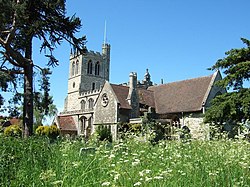Wingrave
| Wingrave | |
| Buckinghamshire | |
|---|---|
 SS Peter & Paul, Wingrave | |
| Location | |
| Grid reference: | SP858183 |
| Location: | 51°51’50"N, -0°44’19"W |
| Data | |
| Population: | 1,512 (2011) |
| Post town: | Aylesbury |
| Postcode: | HP22 |
| Dialling code: | 01296 |
| Local Government | |
| Council: | Buckinghamshire |
| Parliamentary constituency: |
Buckingham |
Wingrave is a village in Buckinghamshire, about four miles north east of Aylesbury and three miles south west of Wing.
The name of Wingrave occurs in the Domesday Book as Withungrave and in 1163 as Wiungraua. It comes from Old English, suggested as Wiþinga grāf or Wēoinga grāf, meaning the Grove of the Withingas", whoc are believed to have named Wing" in Buckinghamshire.
Churches
- Church of England: St Peter and St Paul
- Methodist: (at Nup End)
The former United Reformed Church closed in 2005, although the Congregational churchyard remains as a memorial garden.
Architecture
Around the recreation ground and in other parts of the village are many houses and cottages of varying sizes, constructed in Tudor Revival style, erected by Hannah de Rothschild in the 19th century. These houses, which display her personal cypher 'H de R' were homes for estate employees. They remained part of the Mentmore Estate until well into the 20th century and are very sought after today, commanding a very high price.
Lordship of Burbage in the Parish of Wingrave Buckinghamshire
The Manor of Burbage lies within the Parish of Wingrave, Buckinghamshire. First referred to by name in or about 1465, by Sir Edmund Hampden and called Edmunds Manor. William Hampden was holding Burbage Manor (the first naming as such) at his death in 1525 and the Manor was then passed to his son John Hampden in 1533. The Manor is now, roughly in what is the major part of the Parish of Wingrave Buckinghamshire. The last active Lord of the Manor was Roland William Raven, OBE, FRCS, who on his death passed the estate to his wife Dame Kathleen Raven, the Manor was then passed into the hands of the Royal Collage of Surgeons. The estate eventually sold off all the land and tangible assets leaving the Title and the remaining Manorial Rights which eventually were passed on to the present holder. This is a Feudal Manorial Lordship, or Honour or Dignity, rather than a Peerage. The present holder of the Lordship is Anthony Mealing a Consultant Conservation Architect from High Wycombe in Buckinghamshire.
By ancient custom, the Lord of the Manor of Burbage could require the holder (tenant or freeholder) of the Manor Farm (the three acre fields) to have the Parish Church Floor strewn with fresh cut grass on the first Sunday after St Peter's day (29 June). This custom survived from the 12th century up to the out break of the Second World War.
Wingrave Manor (the building), also known as the 'Old Manor House' is a Victorian half timbered pastiche of nearby Ascott House. Like many of the village's cottages it too was built by Hannah de Rothschild in 1876. The design of the house while similar to Ascott, does not have the same lightness of touch as Ascott, so is unlikely to have been designed by Ascott's architect George Devey. The Rothschild family do not appear to have ever lived at Wingrave, as the house was soon let to the Stewart-Freeman Family who enlarged it in 1885 and eventually purchased it in 1898.
Czech connection
The last Stewart-Freeman daughter, Mary Eveline, Countess of Essex, leased Wingrave Manor to the Czechoslovakian Government in Exile. They leased it for £20 a week as a residence for the employees and families of the Private Office of President Beneš (called the Chancellery). During this time the President Dr Edvard Beneš lived at The Abbey in nearby Aston Abbotts, and his Military Intelligence of the exiled government lived at Addington House in nearby Addington, near Winslow. The offices of the Czechoslovak Government in Exile were at various locations in London.[1]
President Beneš donated a bus shelter to the villages of Aston Abbotts and Wingrave in 1944. This is on the A418 between the two villages. Following the departure of President Beneš's officials in 1945, the Manor was leased to an order of nuns who cared for disabled children on the site for over twenty-five years. In 1998 President Václav Havel, the first post-communist President of Czechoslovakia, visited Wingrave to mark its Czech connections.
MacIntyre School
In 1972 the Manor was sold to become MacIntyre School. MacIntyre school subsequently moved to a new purpose built premises in 2006 approximately 100 metres from the Manor House having sold off the manor house for development. The school cares for children described as having complex learning difficulties, many on the autism spectrum, and was greatly supported by Bob Monkhouse during his lifetime. The school offers residential and day placements.
Outside links
| ("Wikimedia Commons" has material about Wingrave) |
- Wingrave
- Wingrave Community Association
- Wingrave C of E Combined school
- Wingrave Celebrations
- Wingrave Photographic Interest Club
- Czechoslovak Government in Exile Research Society
References
- ↑ Neil Rees "The Secret History of The Czech Connection - The Czechoslovak Government in Exile in London and Buckinghamshire" England, 2005. ISBN 0-9550883-0-5
- Ken & Margaret Morley "Wingrave: A Rothschild Village in the Vale" by Ken & Margaret Morley, ISBN 1-871199-99-9, Published by the Book Castle